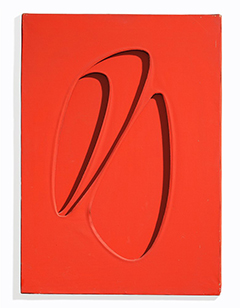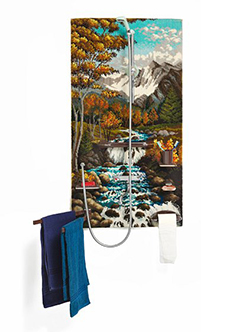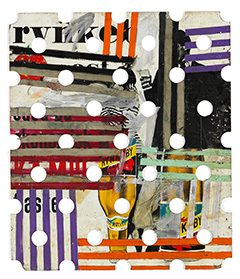Avantgarde in Copenhagen 1960-70



The focal point for everything that happened in Copenhagen at the time was Nikolaj’s Plads, where the German-Danish artist Arthur Köpcke opened his gallery in 1958, which was almost simultaneous with the opening of the Danish artist and project curator Knud Pedersen’s art library in Nikolaj Kirke, where people could come in from the street and rent a painting for the same price as a pack of cigarettes. The two gentlemen worked together on the notorious Fluxus concerts and other happenings in the Church, and they can take a great deal of credit for Copenhagen becoming a rising international art metropolis.
From Scheggi’s Perception of Space to Spoerri’s Kitsch
With a wide range of works, the auction delves deep into the pulsating artistic tendencies of the time. The works include, for instance the Italian Paolo Scheggi’s play with the perception of space in the painting "Intersuperficie curva dal rosso" (curved intersurface from red) from 1962-63, the Swiss artist Daniel Spoerri’s kitschy shower scene ”La douche III Détrompe L’oeil” from 1976, which in the combination of picturesque kitsch and everyday routines plays with the idea of the sublime work of art. From Knud Petersen’s collection we can present Peter Louis-Jensen’s reliefs from 1976 that toured around Zealand on the tailboards of the Faxe Brewery’s beer trucks. Together, the works represent a diverse field of the different movements of contemporary avant-garde at the time, which all had the common goal of transcending the frames of art and play with genres, media and materials in the exploration of the question: What is an art object? Read more
Lecture by Peter Bonnén
The Danish artist Peter Bonnén was a significant part of the art scene during this period, and on the opening day of the preview at Bredgade 33 he will give the lecture "The Experimental Art Scene and Artists in Copenhagen during the 1960s and '70s." The lecture will take place at 4 pm on 15 September.
Classic Danish Modernism
We move back in time with a selection of classic Danish modernism, where Harald Giersing leads the pack with the self-portrait "Karneval" from 1913. During the years around World War I Copenhagen was characterized by a progressive art scene. Together with a number of other artists Giersing came to play a central role in the spread of the early European avant-garde art in Denmark. Two of the other names were Olaf Rude and Edvard Weie. They are represented at the auction with a beautiful Cubist inspired portrayal from 1912 of a young woman in the process of reading and a scene with a reclining nude model from 1916 respectfully.
Storm P’s Watercolour by Fernand Léger
Cubism in a more pure form can be found in the Frenchman Fernand Léger's watercolour "Étude pour le Remorqueur" from 1917. It is a study for a number of the artist's works, which today are on display in major international museums such as the Musée de Grenoble in France. The watercolour is reminiscent of the big city, machinery and industry that fascinated and inspired many of the avant-garde artists. The Danish cartoonist Robert Storm Petersen probably bought the work from the artist himself and had it in his collection until the interwar period, where the present owner's family acquired it from him.
See all the lots of modern art
See all the lots up for auction
Read more about the auction
Read about bidding
For further information, please contact:
Niels Raben: +45 8818 1181 · nr@bruun-rasmussen.dk
Niels Boe Hauggaard: +45 8818 1182 · nbh@bruun-rasmussen.dk
Kathrine Eriksen: +45 8818 1184 · ke@bruun-rasmussen.dk